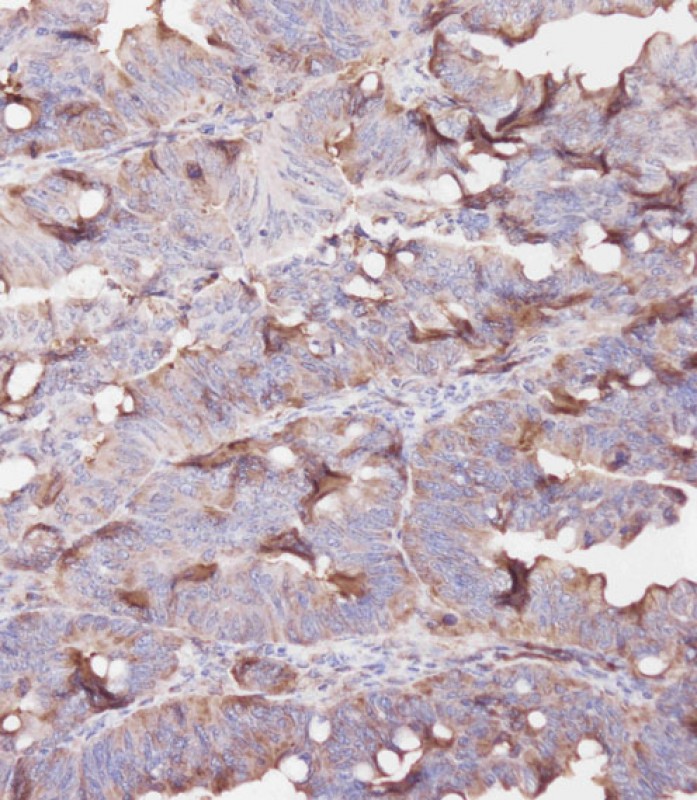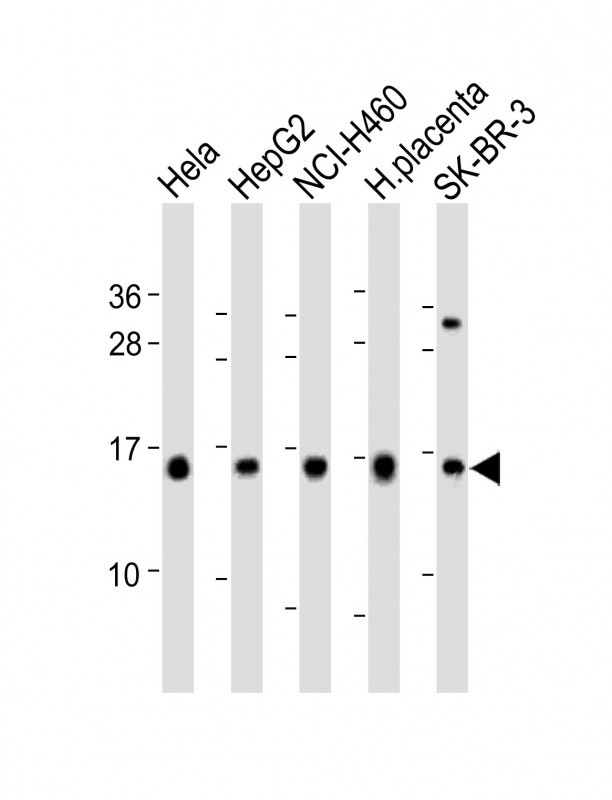Interferon-inducible protein (IFITM3) Antibody (N-term)
Purified Rabbit Polyclonal Antibody (Pab)
- 产品详情
- 文献引用 : 10
- 实验流程
- 背景知识
Application
| IHC-P-Leica, WB, IF, E |
|---|---|
| Primary Accession | Q01628 |
| Reactivity | Human, Rat, Mouse |
| Host | Rabbit |
| Clonality | Polyclonal |
| Isotype | Rabbit IgG |
| Calculated MW | 14632 Da |
| Antigen Region | 1-30 aa |
| Gene ID | 10410 |
|---|---|
| Other Names | Interferon-induced transmembrane protein 3, Dispanin subfamily A member 2b, DSPA2b, Interferon-inducible protein 1-8U, IFITM3 |
| Target/Specificity | This Interferon-inducible protein (IFITM3) antibody is generated from rabbits immunized with a KLH conjugated synthetic peptide between 1-30 amino acids from the N-terminal region of human Interferon-inducible protein (IFITM3). |
| Dilution | IHC-P-Leica~~1:100 WB~~1:2000 IF~~1:100~500 E~~Use at an assay dependent concentration. |
| Format | Purified polyclonal antibody supplied in PBS with 0.09% (W/V) sodium azide. This antibody is purified through a protein A column, followed by peptide affinity purification. |
| Storage | Maintain refrigerated at 2-8°C for up to 2 weeks. For long term storage store at -20°C in small aliquots to prevent freeze-thaw cycles. |
| Precautions | Interferon-inducible protein (IFITM3) Antibody (N-term) is for research use only and not for use in diagnostic or therapeutic procedures. |
| Name | IFITM3 (HGNC:5414) |
|---|---|
| Function | IFN-induced antiviral protein which disrupts intracellular cholesterol homeostasis. Inhibits the entry of viruses to the host cell cytoplasm by preventing viral fusion with cholesterol depleted endosomes. May inactivate new enveloped viruses which buds out of the infected cell, by letting them go out with a cholesterol depleted membrane. Active against multiple viruses, including influenza A virus, SARS coronaviruses (SARS-CoV and SARS-CoV-2), Marburg virus (MARV), Ebola virus (EBOV), Dengue virus (DNV), West Nile virus (WNV), human immunodeficiency virus type 1 (HIV-1), hepatitis C virus (HCV) and vesicular stomatitis virus (VSV) (PubMed:26354436, PubMed:33239446, PubMed:33270927). Can inhibit: influenza virus hemagglutinin protein- mediated viral entry, MARV and EBOV GP1,2-mediated viral entry, SARS- CoV and SARS-CoV-2 S protein-mediated viral entry and VSV G protein- mediated viral entry (PubMed:33270927). Plays a critical role in the structural stability and function of vacuolar ATPase (v-ATPase). Establishes physical contact with the v-ATPase of endosomes which is critical for proper clathrin localization and is also required for the function of the v-ATPase to lower the pH in phagocytic endosomes thus establishing an antiviral state. In hepatocytes, IFITM proteins act in a coordinated manner to restrict HCV infection by targeting the endocytosed HCV virion for lysosomal degradation (PubMed:26354436). IFITM2 and IFITM3 display anti-HCV activity that may complement the anti-HCV activity of IFITM1 by inhibiting the late stages of HCV entry, possibly in a coordinated manner by trapping the virion in the endosomal pathway and targeting it for degradation at the lysosome (PubMed:26354436). Exerts opposing activities on SARS-CoV-2, including amphipathicity-dependent restriction of virus at endosomes and amphipathicity-independent enhancement of infection at the plasma membrane (PubMed:33270927). |
| Cellular Location | Cell membrane; Single-pass type II membrane protein. Late endosome membrane; Single-pass type II membrane protein. Early endosome membrane; Single-pass type II membrane protein Lysosome membrane; Single-pass type II membrane protein. Cytoplasm, perinuclear region. Note=Co-localizes with BRI3 isoform 1 at the perinuclear region. |
Research Areas
For Research Use Only. Not For Use In Diagnostic Procedures.

Application Protocols
Provided below are standard protocols that you may find useful for product applications.
BACKGROUND
The family of interferon-induced transmembrane protein (Ifitm/mil/fragilis) cell surface proteins may modulate cell adhesion and influence cell differentiation.
REFERENCES
Tanaka,S.S., Dev. Cell 9 (6), 745-756 (2005)
终于等到您。ABCEPTA(百远生物)抗体产品。
点击下方“我要评价 ”按钮提交您的反馈信息,您的反馈和评价是我们最宝贵的财富之一,
我们将在1-3个工作日内处理您的反馈信息。
如有疑问,联系:0512-88856768 tech-china@abcepta.com.
¥ 1,250.00
Cat# AP1153a






















 癌症的基本特征包括细胞增殖、血管生成、迁移、凋亡逃避机制和细胞永生等。找到癌症发生过程中这些通路的关键标记物和对应的抗体用于检测至关重要。
癌症的基本特征包括细胞增殖、血管生成、迁移、凋亡逃避机制和细胞永生等。找到癌症发生过程中这些通路的关键标记物和对应的抗体用于检测至关重要。 为您推荐一个泛素化位点预测神器——泛素化分析工具,可以为您的蛋白的泛素化位点作出预测和评分。
为您推荐一个泛素化位点预测神器——泛素化分析工具,可以为您的蛋白的泛素化位点作出预测和评分。 细胞自噬受体图形绘图工具为你的蛋白的细胞受体结合位点作出预测和评分,识别结合到自噬通路中的蛋白是非常重要的,便于让我们理解自噬在正常生理、病理过程中的作用,如发育、细胞分化、神经退化性疾病、压力条件下、感染和癌症。
细胞自噬受体图形绘图工具为你的蛋白的细胞受体结合位点作出预测和评分,识别结合到自噬通路中的蛋白是非常重要的,便于让我们理解自噬在正常生理、病理过程中的作用,如发育、细胞分化、神经退化性疾病、压力条件下、感染和癌症。









